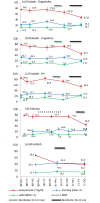Assessment of the effectiveness of a small quantity lipid-based nutrient supplement on reducing anaemia and stunting in refugee populations in the Horn of Africa: Secondary data analysis
- PMID: 28591166
- PMCID: PMC5462343
- DOI: 10.1371/journal.pone.0177556
Assessment of the effectiveness of a small quantity lipid-based nutrient supplement on reducing anaemia and stunting in refugee populations in the Horn of Africa: Secondary data analysis
Abstract
Stunting and micronutrient malnutrition are persistent public health problems in refugee populations. UNHCR and its partner organisations implement blanket supplementary feeding programmes using a range of special nutritional products as one approach to address these issues. The evidence base for the efficacy and effectiveness of a small quantity lipid-based nutrient supplement, Nutributter®, in reducing stunting and anaemia is limited. Secondary data analysis was used to assess the effectiveness of Nutributter® distribution on anaemia and stunting in children aged 6-23 months (programme target group) and 6-59 months (the standard age group sampled in routine nutrition surveys). Analysis was conducted using routine pre and post-intervention cross-sectional nutrition survey data collected between 2008-2011 in five refugee camps in Kenya and Djibouti. Changes in total anaemia (Haemoglobin<110g/L), anaemia categories (mild, moderate and severe), and stunting (height-for-age z-score <-2) were explored using available data on the Nutributter® programme and contextual factors. A significant reduction in the prevalence of anaemia in children aged 6-23 months and 6-59 months was seen in four of five, and in all five camps, respectively (p<0.05). Reductions ranged from 12.4 to 23.0, and 18.3 to 29.3 percentage points in each age group. Improvements were largely due to reductions in moderate and severe anaemia and occurred where the prevalence of acute malnutrition was stable or increasing. No change in stunting was observed in four of five camps. The replicability of findings across five sites strongly suggests that Nutributter® distribution was associated with a reduction in anaemia, but not stunting, among refugee children in the Horn of Africa. Benefits were not restricted to the 6-23 month target group targeted by the nutrition programme. However, even following this intervention anaemia remained a serious public health problem and additional work to define and evaluate an effective intervention package is warranted.
Conflict of interest statement
Figures
References
-
- Blanck HM, Bowman BA, Serdula MK, Khan LK, Kohn W, Woodruff BA. Angular stomatitis and riboflavin status among adolescent Bhutanese refugees living in southeastern Nepal. AmJClinNutr. 2002;76(2):430–5. - PubMed
-
- Hassan K, Sullivan KM, Yip R, Woodruff BA. Factors associated with anemia in refugee children. JNutr. 1997;127(11):2194–8. - PubMed
-
- Kemmer TM, Bovill ME, Kongsomboon W, Hansch SJ, Geisler KL, Cheney C, et al. Iron deficiency is unacceptably high in refugee children from Burma. JNutr. 2003;133(12):4143–9. - PubMed
-
- McGready R, Simpson JA, Arunjerdja R, Golfetto I, Ghebremeskel K, Taylor A, et al. Delayed visual maturation in Karen refugee infants. AnnTropPaediatr. 2003;23(3):193–204. - PubMed
MeSH terms
Substances
LinkOut - more resources
Full Text Sources
Other Literature Sources
Medical



